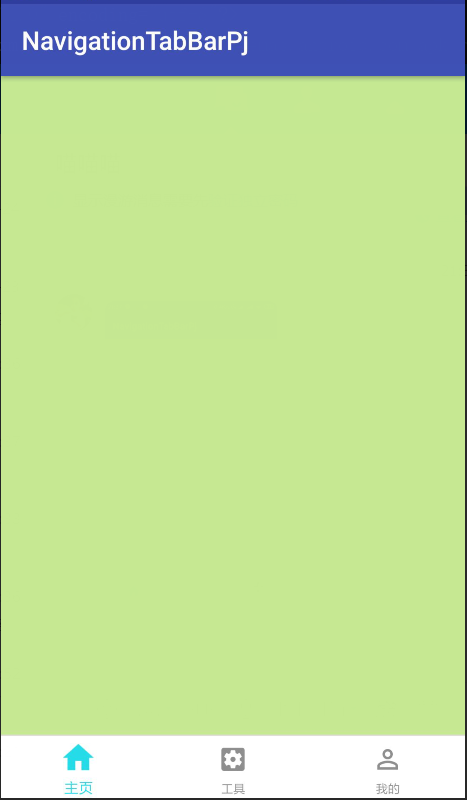NavigationTabBar 自定義底部導航欄
阿新 • • 發佈:2018-12-27
先來頁面效果

匯入依賴
implementation 'devlight.io:navigationtabbar:1.2.5'
先建立三個Fragment ,貼出其中一個Fragment 的程式碼
fragment_home.xml
<?xml version="1.0" encoding="utf-8"?><android.support.constraint.ConstraintLayout xmlns:android="http://schemas.android.com/apk/res/android" android:background="#AAdd" android:layout_width="match_parent" android:layout_height="match_parent"></android.support.constraint.ConstraintLayout>
HomeFragment.java
public class HomeFragment extends Fragment { @Nullable
@Override
public View onCreateView(@NonNull LayoutInflater inflater, @Nullable ViewGroup container, @Nullable Bundle savedInstanceState) {
View view = inflater.inflate(R.layout.fragment_home, container, false); return view;
} @Override
public void onViewCreated(@NonNull View view, @Nullable Bundle savedInstanceState) { super.onViewCreated(view, savedInstanceState);
}
}新建一個Activity TabActivity
xml檔案程式碼
<?xml version="1.0" encoding="utf-8"?><LinearLayout xmlns:android="http://schemas.android.com/apk/res/android" xmlns:app="http://schemas.android.com/apk/res-auto" xmlns:tools="http://schemas.android.com/tools" android:layout_width="match_parent" android:layout_height="match_parent" android:orientation="vertical" tools:context=".TabAcitvity"> <FrameLayout android:id="@+id/act_all_fragment_fl" android:layout_width="match_parent" android:layout_height="0dp" android:layout_weight="1" > </FrameLayout> <!--分割線--> <LinearLayout android:layout_width="match_parent" android:background="#dddddd" android:layout_height="1dp"> </LinearLayout> <devlight.io.library.ntb.NavigationTabBar android:id="@+id/ntb_horizontal" android:layout_width="match_parent" android:layout_height="48dp" app:ntb_bg_color="#fff" app:ntb_icon_size_fraction="0.5" app:ntb_active_color="#25dbe7" app:ntb_inactive_color="#8e8e8e" app:ntb_animation_duration="0" app:ntb_badged="false" app:ntb_scaled="true" app:ntb_tinted="true" app:ntb_title_mode="all" app:ntb_badge_bg_color="#fff" app:ntb_titled="true" app:ntb_swiped="false"/></LinearLayout>
java程式碼
public class TabAcitvity extends AppCompatActivity { private HomeFragment homeFragment; private MeFragment meFragment; private settingFragment settingFragment;// private ViewPager viewPager;
private NavigationTabBar navigationTabBar; @Override
protected void onCreate(final Bundle savedInstanceState) { super.onCreate(savedInstanceState);
setContentView(R.layout.activity_tab_acitvity);
initUI();
} private void initUI() {// viewPager = findViewById(R.id.vp_horizontal_ntb);
//例項化fragment
homeFragment = new HomeFragment();
meFragment = new MeFragment();
settingFragment = new settingFragment();
getSupportFragmentManager().beginTransaction().add(R.id.act_all_fragment_fl, homeFragment)
.add(R.id.act_all_fragment_fl, meFragment)
.add(R.id.act_all_fragment_fl,settingFragment).commitAllowingStateLoss();
getSupportFragmentManager().beginTransaction().show(homeFragment)
.hide(meFragment)
.hide(settingFragment).commitAllowingStateLoss();
navigationTabBar = findViewById(R.id.ntb_horizontal); //設定底部Tab 圖示的標題
String[] titles = new String[]{"主頁", "工具", "我的"};
ArrayList<View> views = new ArrayList<>(); //設定每個View的不同背景
int[] viewBgs = new int[]{Color.RED, Color.GRAY, Color.BLUE}; //設定底部Tab的各個圖示
int[] icons = new int[]{R.drawable.icon_home, R.drawable.icon_setting, R.drawable.icon_me}; //用來生成各個不同選項的
ArrayList<NavigationTabBar.Model> models = new ArrayList<>(); for (int i = 0; i < titles.length; i++) {
models.add( new NavigationTabBar.Model.Builder(
getResources().getDrawable(icons[i]),
Color.parseColor("#00000000"))// .selectedIcon(getResources().getDrawable(R.drawable.ic_sixth))
.title(titles[i])// .badgeTitle("NTB") //角標
.build()
);
View view = new View(this);// view.setBackgroundColor(viewBgs[i]);// views.add(view);
}// viewPager.setAdapter(new TabAdapter(this, views));
navigationTabBar.setModels(models);
navigationTabBar.setModelIndex(0);
navigationTabBar.setOnTabBarSelectedIndexListener(new NavigationTabBar.OnTabBarSelectedIndexListener() { @Override
public void onStartTabSelected(NavigationTabBar.Model model, int index) { switch (index) { case 0:
getSupportFragmentManager().beginTransaction().show(homeFragment)
.hide(meFragment)
.hide(settingFragment).commitAllowingStateLoss(); break; case 1:
getSupportFragmentManager().beginTransaction().show(settingFragment)
.hide(meFragment)
.hide(homeFragment).commitAllowingStateLoss(); break; case 2:
getSupportFragmentManager().beginTransaction().show(meFragment)
.hide(homeFragment)
.hide(settingFragment).commitAllowingStateLoss(); break;
}
} @Override
public void onEndTabSelected(NavigationTabBar.Model model, int index) {
}
});
}
}
